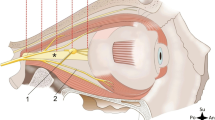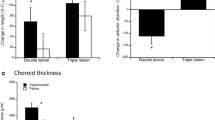Abstract
Cynomolgus monkeys underwent unilateral ciliary ganglionectomy (CG) and/or posterior ciliary neurectomy (PCN). The ciliary muscle was functionally denervated, as evidenced by loss of choline acetyltransferase activity, loss of the accommodative response to topical eserine and electrical stimulation of the Edinger-Westphal nucleus, and supersensitivity of the accommodative response to pilocarpine [5, 6, 7]. Light and electron microscopy carried out 3–28 days after CG/PCN revealed degeneration of myelinated and unmyelinated nerve fibers as evidenced by axonal swelling and shrinkage, mitochondrial degeneration, axoplasmic condensation and vacuolization, and activated, phagocytosing Schwann cells. By 1–3 months after CG/PCN, few non-myelinated axons remained between the muscle bundles, larger nerve bundles were disordered and deteriorated, and Schwann cells filled with lipid and cellular debris were prominent. Beyond 6 months (6–37 months), most eyes were reinnervated by functional criteria. Concurrently, the ciliary neuromuscular morphology appeared virtually normal, exhibiting many non-myelinated axons containing numerous agranular synaptic vesicles and large mitochondria; however, remnants of degenerated axons were still present. In two eyes remaining functionally denervated, many of the unmyelinated axons between the ciliary muscle bundles were swollen or empty, with small, degenerated mitochondria and only rare synaptic vesicles, and were often ensheathed by thickened, condensed Schwann-cell cytoplasm. The muscle fibers were atrophic and separated from each other as well as from the ensheathed nerve fibers. Thus, following CG/PCN, the morphologic and functional evidence of parasympathetic denervation and reinnervation of the ciliary muscle is pathophysiologically and temporally consistent.
Similar content being viewed by others
References
Armaly MF (1968) Degeneration of ciliary muscle and iris sphincter following resection of the ciliary ganglion. Trans Am Ophthalmol Soc 66:476–502
Christensen K (1935) Sympathetic and parasympathetic nerves in the orbit of the cat. J Anat 70:225–233
Erickson KA, Gonnering RS, Kaufman PL, Dortzbach RK (1984) The cynomolgus monkey as a model for orbital research: III. Effects on ocular physiology of lateral orbitotomy and isolation of the ciliary ganglion. Curr Eye Res 3:557–564
Erickson-Lamy KA, Kaufman PL (1986) Cholinergic reinnervation of the ciliary muscle following ciliary ganglionectomy in the cynomolgus monkey. ARVO Abstracts. Invest Ophthalmol Vis Sci 27[Suppl]:288
Erickson-Lamy KA, Kaufman PL (1987) Reinnervation of primate ciliary muscle following ciliary ganglionectomy. Invest Ophthalmol Vis Sci 28:927–933
Erickson-Lamy KA, Kaufman PL, Polansky JR (1988) Dissociation of cholinergic supersensitivity from receptor number in ciliary muscle. Invest Ophthalmol Vis Sci 29:600–605
Erickson-Lamy KA, Johnson CD, Gabelt BT, Kaufman PL (1989) Ciliary muscle ChAT and AChE after ciliary ganglionectomy. Exp Eye Res (in press)
Gonnering RS, Dortzbach RK, Erickson KA, Kaufman PL (1984) The cynomolgus monkey as a model for orbital research: II. Anatomic effects of lateral orbitotomy. Curr Eye Res 3:541–555
Gordon-Weeks P, Gabella G (1977) Degeneration of varicose axons and their phagocytosis by smooth muscle cells. J Neurocytol 6:711–721
Grimes P, Sallman L von (1960) Comparative anatomy of the ciliary nerves. Arch Ophthalmol 64:81–91
Ito S, Karnovsky MJ (1968) Formaldehyde-glutaraldehyde fixatives containing trinitro compounds. J Cell Biol 39:168a
Kaufman PL, Wiedman T, Robinson JR (1984) Cholinergics. In: Sears ML (ed) Pharmacology of the eye. Springer, Berlin Heidelberg New York, pp 149–191 (Handbook of experimental pharmacology series, vol 69)
Lütjen-Drecoll E, Kaufman PL (1986) Biomechanics of echothiophate-induced anatomic changes in monkey aqueous outflow system. Graefe’s Arch Clin Exp Ophthalmol 224:564–575
Rohen JW (1965) Morphology of the uveal tract. Int Ophthalmol Clin 5:581–667
Rohen JW (1969) Anatomie des Auges. In: Velhagen K (ed) Der Augenarzt, 2nd edn. Thieme, Leipzig, pp 1–206
Ruskell GL (1982) Innervation of the anterior segment of the eye. In: Lütjen-Drecoll E (ed) Basis aspects of glaucoma research. Schattauer, Stuttgart, pp 49–68
Sunderland S (1978) Nerves and nerve injuries, 2nd edn. Churchill Livingstone, Edinburgh
Townes E, Raviola G (1978) Degeneration and regeneration of autonomic nerve endings in the anterior part of rhesus monkey ciliary muscle. J Neurocytol 7:583–600
Warwick R (1976) Wolff’s anatomy of the eye and orbit. Saunders, Philadelphia
Author information
Authors and Affiliations
Rights and permissions
About this article
Cite this article
Rohen, J.W., Eichhorn, M., Kaufman, P.L. et al. Ciliary neuromuscular morphology in cynomolgus monkeys after ciliary ganglionectomy. Graefe’s Arch Clin Exp Ophthalmol 228, 49–54 (1990). https://doi.org/10.1007/BF02764291
Received:
Accepted:
Issue Date:
DOI: https://doi.org/10.1007/BF02764291




